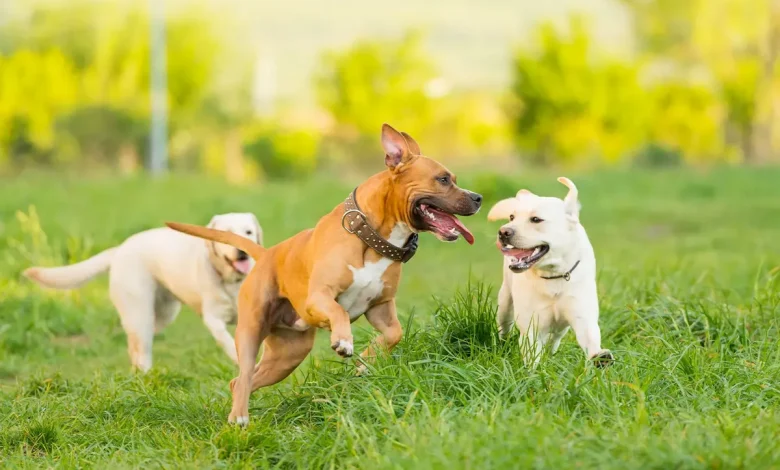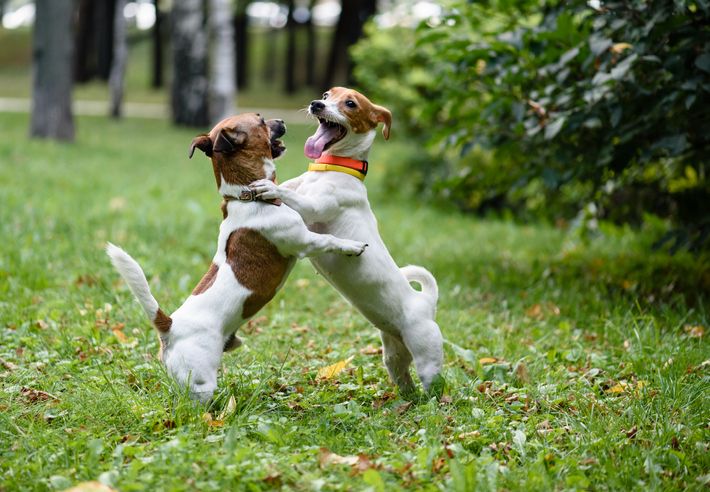
Play fighting among dogs is a common and natural behavior that often occurs during playtime. While it can look intense and even aggressive, it’s usually a healthy way for dogs to socialize and exercise. However, distinguishing between playful roughhousing and genuine aggression is crucial for ensuring your pets’ safety. This blog will help you understand how to identify safe play fighting, recognize the signs of trouble, and manage your dogs’ interactions to keep them happy and healthy.
Recognizing Safe Play Fighting
Play fighting, also known as play wrestling, is characterized by specific behaviors that differentiate it from real fighting. Here’s what to look for to determine if your dogs’ play fighting is safe:
- Play Bow: Dogs often initiate play fighting with a “play bow,” where they lower their front legs and raise their hindquarters.
- Relaxed Bodies: During safe play, dogs’ bodies should appear loose and relaxed. If their muscles are tense or they seem rigid, it might be a sign that something is wrong.
- Mutual Participation: Both dogs should be actively participating and enjoying the play. If one dog appears to be more dominant or the other seems uncomfortable or trying to escape, it could indicate a problem.
- Balanced Play: Play fighting should involve a mix of roles. Dogs take turns being the “top” and “bottom,” with neither dog consistently dominating the other.
- Non-Destructive Play: Safe play fighting does not involve biting or clawing with force. The play should be gentle and controlled, with minimal risk of injury.
Signs That Play Fighting May Be Unsafe
Even if play fighting seems to be going well, there are red flags to watch out for that could indicate the play has become too rough or aggressive:
- Excessive Growling or Snarling: While some growling can be normal, excessive or continuous growling may signal that one dog is feeling threatened.
- Lack of Play Signals: If one dog stops displaying play signals like the play bow or wagging tail, and the play seems to become one-sided, it could be a sign of discomfort or aggression.
- Injury or Pain: If you notice any physical injuries, such as scratches, bites, or signs of pain, it’s essential to intervene immediately.
- Signs of Stress: Look for signs of stress in your dogs, such as panting, heavy breathing, or a lowered tail. If a dog is showing these signs, the play should be stopped.
- One Dog Trying to Escape: If one dog is consistently trying to leave or hide, it’s a sign that they are not enjoying the play and may be feeling overwhelmed.
How to Manage Play Fighting
Managing your dogs’ play fighting can help ensure it remains safe and enjoyable. Here are some tips for effective management:
- Supervision: Always supervise playtime to ensure that it remains friendly and safe. Step in if the play seems to be getting too rough.
- Interrupt and Redirect: If play fighting becomes too intense, interrupt the play and redirect their attention to a different activity, like a toy or a walk.
- Provide Separate Spaces: If necessary, give each dog their own space to retreat to if they need a break from playtime. This helps prevent overstimulation and allows them to calm down.
- Training: Training your dogs in basic commands like “sit” and “stay” can help you manage their behavior and control the play environment.
Monitoring Play Over Time
As your dogs grow and their play styles evolve, it’s important to continuously monitor their interactions. Regularly assess how they play and make adjustments as needed to ensure their safety. Additionally, observe how they interact with other dogs, as their play behavior can differ based on the social dynamics with different animals.
Promoting Healthy Play

When it comes to maintaining your dogs’ health, the right nutrition is crucial. Skipper’s Pet Products, founded in 2013 by Steve Moore in Grimsby, UK, is dedicated to providing premium dog treats that support overall well-being. Their products are made from ethically sourced materials, including fish co-products like Fish Skin, and use recycled energy for low-temperature drying. This sustainable approach ensures that the treats are not only nutritious but also environmentally friendly, aligning with the natural playfulness of your pets by supporting their health and energy levels.
Conclusion:
Play fighting is an essential part of your dogs’ socialization and physical exercise, but it’s important to recognize when it becomes unsafe. By understanding the signs of healthy play, managing interactions effectively, and providing proper nutrition, you can ensure that your dogs’ playtime remains enjoyable and beneficial. Remember to always monitor their behavior, intervene when necessary, and consult with a veterinarian or a professional dog trainer if you have concerns. Happy playing!









